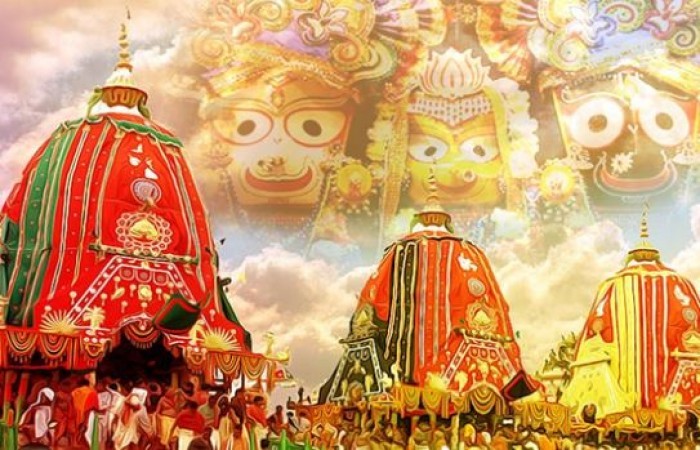
The Rath Yatra of Lord Jagannath is a vibrant and deeply significant festival in the Hindu tradition, particularly renowned in the state of Odisha, India. This annual procession involves the ceremonial journey of Lord Jagannath, along with his siblings Lord Balabhadra and Devi Subhadra, from their temple in Puri to the Gundicha Temple, situated about 2 kilometers away. This article explores the historical, cultural, and spiritual dimensions of the Rath Yatra, elucidating its origins, rituals, and enduring relevance.
Origins and Historical Significance
The Rath Yatra has ancient roots, dating back thousands of years, and is steeped in both legend and historical accounts. According to mythology, Lord Jagannath, an incarnation of Lord Vishnu, desires to visit his birthplace, Gundicha Temple, once a year. This pilgrimage symbolizes the journey of the divine towards his devotees and underscores the idea of divine grace and accessibility.
Historically, the Rath Yatra gained prominence during the reign of King Anantavarman Chodaganga Deva of the Eastern Ganga Dynasty in the 12th century. The king is credited with formalizing and popularizing the festival as a grand public event, accessible to all devotees irrespective of caste, creed, or social status. Over time, the Rath Yatra became not only a religious observance but also a socio-cultural phenomenon, drawing millions of devotees and tourists from across the globe.
Rituals and Preparation
Preparations for the Rath Yatra commence weeks in advance with meticulous planning and elaborate rituals. The construction of the massive chariots (raths) for Lord Jagannath (Nandighosa), Lord Balabhadra (Taladhwaja), and Devi Subhadra (Darpadalana) begins months prior to the festival. These towering chariots, each uniquely designed and adorned with colorful decorations, symbolize the journey of the deities to Gundicha Temple.
The rituals associated with the Rath Yatra are intricate and carried out with utmost precision. The ceremonial installation of the deities onto their respective chariots (pahandi) is a moment of great reverence, accompanied by chanting of hymns and prayers. The pulling of the chariots by thousands of devotees through the streets of Puri is a spectacle that captures the spirit of devotion and unity.
Spiritual Significance and Symbolism
The Rath Yatra holds profound spiritual significance in Hindu philosophy. It signifies the unity of various paths (yogas) that lead to the divine, as the journey of Lord Jagannath on the chariot represents the journey of the soul towards spiritual realization. The act of pulling the chariots is seen as an act of devotion and a means of earning divine blessings.
Symbolically, the chariots represent the human body, which houses the divine within. The pulling of the chariots by devotees symbolizes the surrender of the ego and the effort to overcome worldly attachments, thereby seeking the divine grace of Lord Jagannath.
Cultural Impact and Global Appeal
Beyond its religious and spiritual significance, the Rath Yatra has a profound cultural impact. It serves as a unifying force, bringing together people from diverse backgrounds and fostering a sense of community and harmony. The festival has transcended geographical boundaries and attracts international attention, contributing significantly to the cultural heritage of India.
The Rath Yatra of Puri has inspired similar festivals in various parts of the world, celebrating the universal appeal of devotion and spiritual unity. In recent years, efforts have been made to promote the festival as a global cultural event, highlighting its artistic, architectural, and philosophical dimensions.
Challenges and Contemporary Relevance
In contemporary times, the Rath Yatra faces challenges such as logistical complexities, ensuring safety measures for the massive crowds, and preserving the traditional aspects amidst modernization. Efforts are ongoing to maintain the sanctity and authenticity of the rituals while accommodating the needs of a global audience.
Despite these challenges, the Rath Yatra continues to thrive as a testament to the enduring faith and devotion of millions of devotees. It serves as a reminder of the timeless teachings of Hindu philosophy, emphasizing love, compassion, and spiritual liberation.
In conclusion, the Rath Yatra of Lord Jagannath in Puri is more than a religious festival; it is a celebration of faith, unity, and cultural heritage. Through its elaborate rituals, vibrant festivities, and profound symbolism, the Rath Yatra continues to inspire and captivate devotees and visitors alike. As the chariots of Lord Jagannath, Lord Balabhadra, and Devi Subhadra make their annual journey to Gundicha Temple, they carry with them the aspirations and prayers of millions, reaffirming the timeless bond between the divine and humanity.
In essence, the Rath Yatra of Lord Jagannath stands as a testament to the enduring spiritual traditions of India and serves as a beacon of hope and unity in an ever-changing world.
Unlock the Power of Shankha: Discover its Religious and Health Significance
Which is the oldest religion in the world? Find out where Hinduism ranks